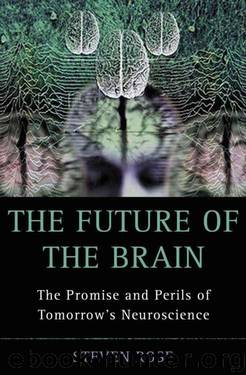The Future of the Brain:The Promise and Perils of Tomorrow's Neuroscience by Rose Steven

Author:Rose, Steven [Rose, Steven]
Language: eng
Format: epub, pdf
Publisher: Oxford University Press
Published: 2005-03-31T21:00:00+00:00
Fig. 7.1 Amyloid plaque.
Fig. 7.2 MRI scans of medial temporal lobe in a ‘normal’ subject and one suffering from Alzheimer’s Disease; note the four-fold reduction in the thickness of the brain tissue at the arrows.
Evidence about the environmental risk factors is equally tenuous. Head injury and general anaesthesia whilst young are said to be risk factors. About thirty years ago there was a scare that aluminium in the diet might be involved, and many families got rid of their aluminium cooking utensils. The scare originated from the discovery that amyloid plaques have a high concentration of aluminium, but it is now clear that this is because the plaques trap the metal, scavenging it from the surrounding extracellular fluids, rather than the aluminium causing the plaques to form. Free radicals and prions – those deformed proteins involved in Creutzfeld-Jacob disease and implicated in the transfer of the disease from cattle to humans in the BSE epidemic – have been blamed, but without strong evidence. The greater prevalance in older women than in men had suggested that the loss of oestrogen post-menopause might be responsible, and there was some encouragement for this view from epidemiological studies suggesting that hormone replacement therapy offered a degree of neuroprotection.15 However, the more recent international multicentre trials, whilst not yet complete, are said to be dampening some of the early optimism. Perhaps more interesting is that the risk of contracting Alzheimer’s slightly decreases with increased educational level and a life involving mental rather than manual labour. This has generated a sort of ‘use it or lose it’ argument and suggestions that the best way to avoid the disease is to keep one’s brain active in old age, even if only by doing crossword puzzles or knitting. This would seem sensible advice to all of us as we age, as withdrawal from active engagement in the world can precipitate a spiral of decline, but its specific relevance to AD is unclear.
Whatever the more distal causes, the immediate biochemical cascade that leads to the formation of the plaques and tangles is now relatively well understood. There are two protein players in the drama: the tau protein – a component of microtubules – which constitutes much of the tangles, and the amyloid precursor protein, APP, the breakdown of which results in the beta-amyloid peptides that compose the plaques. A battle-royal between two schools of thought as to which is the primary event has raged for several years. With the heavy schoolboy humour that characterises many lab scientists, the rival groups were named Tauists and B-apptists; the issue is still not settled, but the weight of evidence is on the side of the latter.16
What seems to happen is this. APP is a protein embedded in the neuronal cell membrane, where it is one of a family of molecules which function both in signalling between cells and also in maintaining their configuration – notably at the synapse. In the normal course of things, APP is broken down by enzymes called secretases
Download
The Future of the Brain:The Promise and Perils of Tomorrow's Neuroscience by Rose Steven.pdf
This site does not store any files on its server. We only index and link to content provided by other sites. Please contact the content providers to delete copyright contents if any and email us, we'll remove relevant links or contents immediately.
Periodization Training for Sports by Tudor Bompa(8170)
Why We Sleep: Unlocking the Power of Sleep and Dreams by Matthew Walker(6618)
Paper Towns by Green John(5089)
The Immortal Life of Henrietta Lacks by Rebecca Skloot(4525)
The Sports Rules Book by Human Kinetics(4292)
Dynamic Alignment Through Imagery by Eric Franklin(4116)
ACSM's Complete Guide to Fitness & Health by ACSM(3989)
Kaplan MCAT Organic Chemistry Review: Created for MCAT 2015 (Kaplan Test Prep) by Kaplan(3939)
Introduction to Kinesiology by Shirl J. Hoffman(3725)
Livewired by David Eagleman(3683)
The Death of the Heart by Elizabeth Bowen(3551)
The River of Consciousness by Oliver Sacks(3539)
Alchemy and Alchemists by C. J. S. Thompson(3449)
Bad Pharma by Ben Goldacre(3355)
Descartes' Error by Antonio Damasio(3230)
The Emperor of All Maladies: A Biography of Cancer by Siddhartha Mukherjee(3064)
The Gene: An Intimate History by Siddhartha Mukherjee(3047)
The Fate of Rome: Climate, Disease, and the End of an Empire (The Princeton History of the Ancient World) by Kyle Harper(3003)
Kaplan MCAT Behavioral Sciences Review: Created for MCAT 2015 (Kaplan Test Prep) by Kaplan(2936)
